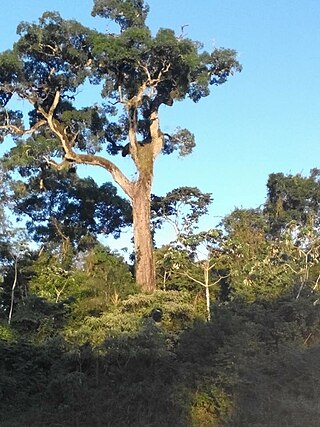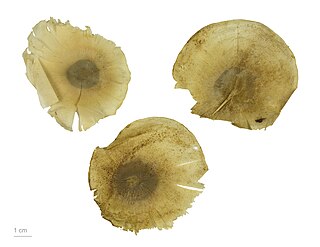
Schinopsis is a genus of South American trees in the family Anacardiaceae, also known by the common names quebracho, quebracho colorado and red quebracho. In Brazil it is known as baraúna or braúna.

Aspidosperma quebracho-blanco, commonly known as Quebracho blanco, kebrako, or white quebracho, is a South American tree species, native to Brazil, northern Argentina, Bolivia, Paraguay, and Uruguay. It must not be confused with other species also known as quebracho, but belonging to the genus Schinopsis.
Aspidosperma excelsum is a tree in the Dogbane family Apocynaceae which grows up to one hundred feet in height. It is native to Peru, Bolivia, Colombia, Venezuela, the Guianas, Panama, and Costa Rica. Its most interesting characteristic is its trunk, which has a deeply sinuous cross-section, usually described as stellate, It is thought these sinuosities offer some protection against strangling figs, Copay and other stranglers by making it more difficult to encircle the tree's cambium.

Aspidosperma cylindrocarpon is a timber tree native to Brazil, Paraguay, Bolivia, and Peru. It is common in Atlantic Forest, Cerrado and Pantanal vegetation of Brazil. This plant is cited in Flora Brasiliensis by Carl Friedrich Philipp von Martius. In addition, it is useful for beekeeping.

Aspidosperma macrocarpon is a timber tree native to Brazil, Venezuela, Bolivia, Paraguay, and Peru. It is common in Cerrado vegetation. It has a self-supporting growth form with simple, broad leaves. This plant is cited in Flora Brasiliensis by Carl Friedrich Philipp von Martius, and it is useful for beekeeping. Individual plants can grow up to 25 m.

Aspidosperma parvifolium is a timber tree native to Brazil, which is typical of Atlantic Forest, Cerrado, Caatinga, and Pantanal vegetation. This plant is cited in Flora Brasiliensis by Carl Friedrich Philipp von Martius. In addition, it is useful for beekeeping.

Aspidosperma polyneuron is a timber tree native to Brazil, Colombia, Peru, Argentina, and Paraguay. It is common in Atlantic Forest vegetation. In addition, it is useful for beekeeping.

Aspidosperma is a genus of flowering plant in the family Apocynaceae, first described as a genus in 1824. It is native to South America, Central America, southern Mexico, and the West Indies.
Aspidosperma darienense is a species of plant in the family Apocynaceae. It is native to Panama, Colombia, Ecuador, French Guiana, and northern Brazil. It is threatened by habitat loss.

Aspidosperma megalocarpon is a species of plant in the family Apocynaceae. It can be found in Belize, Colombia, Ecuador, El Salvador, Guatemala, Honduras, Mexico, Nicaragua, Panama, Suriname, Venezuela, and NW Brazil.
Aspidosperma triternatum is a species of plant in the family Apocynaceae. It is found in Argentina and Paraguay.
Epidendrum spruceanum is an epiphytic reed-stemmed Epidendrum orchid native to the Tropical rainforest of Peru, Bolivia, and Brazil.
Peroba, paroba, parova, perobeira, perova and peroveira are common names for various tree species in the families:

Dracontium spruceanum is a tropical flowering plant species of the Amazon rainforest understory. It has been found in the South American countries of Colombia, Ecuador, Peru, Suriname, and Venezuela, as well as in the Central American countries of Costa Rica and Panama.

Calycophyllum spruceanum, common names capirona and Pau-Mulato, is a canopy tree belonging to the Gardenia Family (Rubiaceae) indigenous to the Amazon rainforest. Its most interesting characteristic is its very shiny, highly polished green bark. The oblong leaves are up to seven inches in length. The white flowers are in small terminal clusters.
Soridium is a genus of myco-heterotrophic plants in the Triuridaceae, lacking chlorophyll and obtaining nutrients from fungi in the soil. It contains only one known species, Soridium spruceanum, native to Brazil, Venezuela, Suriname, French Guiana, Belize and Guatemala.

Thaumatophyllum is a genus of flowering plants in the arum family, Araceae. Its species are native to northern (tropical) South America.

Apparicine is a monoterpenoid indole alkaloid. It is named after Apparicio Duarte, a Brazilian botanist who studied the Aspidosperma species from which apparicine was first isolated. It was the first member of the vallesamine group of alkaloids to be isolated and have its structure established, which was first published in 1965. It has also been known by the synonyms gomezine, pericalline, and tabernoschizine.












